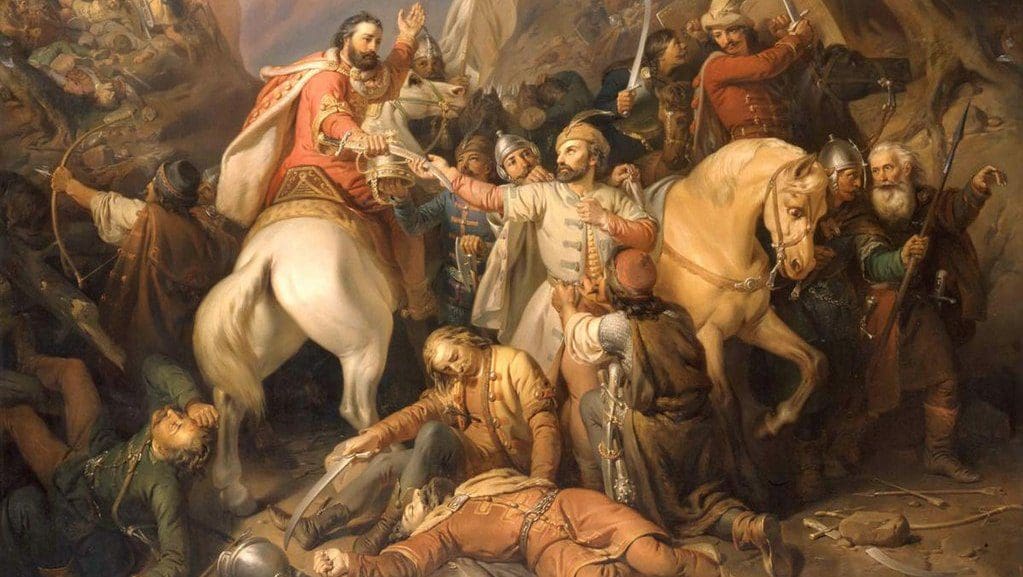
The history of the Order starts in 1271 with the King of Naples, Charles II of Anjou-Sicily, and his consort Queen Mary of Hungary: on the 8th September their son Charles Martel, the eldest of eleven children, was born. At the age of 18, Charles Martel succeeded his childless uncle, Ladislaus IV as King of Hungary. Sadly, his administration was ineffective and he returned to Naples where he settled down to raising a family: his eldest son, Charles Robert (known as Caroberto) aged only twelve, was ordered by his grandfather, with Papal support, to claim the throne of Hungary.

The young Caroberto, now King Charles Robert I of Hungary, inherited an unenviable situation with the country torn apart by numerous factions seeking to seize the vacant throne of Ladislaus, while only two nobles actually supported his succession. The Hungarian holy crown of St Stephen had been hidden to prevent it falling into the wrong hands, so Caroberto was initially crowned on two separate occasions with an interim crown, which action cast doubt on the legitimacy of his rule. Finally, Caroberto was crowned with the crown of St Stephen in 1310 by the Archbishop of Esztergom, so establishing without doubt the legality of his position. However, that was not the end of the matter: rebellious nobles continued to challenge the authority of Caroberto until he faced them head-on at the battle of Rozgony in 1312. Victory in this battle initiated a period of reform in all areas of the governance of Hungary, heralding an extended period of progress, peace and prosperity. In particular a new fraternal society of knights, chosen for their loyal service, rather than by right of birth, was established and developed under Caroberto and his son Lajos. By 23rd April 1326 this fraternal society had evolved into an order of chivalry named after St George, recognised by a foundation document and a ceremony in the presence of many spiritual and temporal leaders. The so-called Golden Age of Hungary continued under Caroberto and Lajos until 1382.

There now ensued a period of turmoil centred on the succession of Lajos’ daughter Mary. The result was the creation of a Grand Master for the Order of St George, carrying both the authority of being the King’s representative and the power to create knights. The Order grew in influence and was important in the stability of the country during the ensuing regency of Sigismund. On the death of Sigismund, it became apparent that a corps of only fifty knights could not reasonably police all the states of Hungary, so in 1437 the fifty founding knights became the Grand Magistry of a much enlarged military order: the Grand Master was therefore both the King’s representative and the Commander in Chief of this national security force.
In the following centuries, the Order, in various forms, continued in a pivotal role in the defence of the Hungarian state becoming the eventual predecessor of the Hungarian defence forces. In 1848 this comprised ten battalions numbering 10,000 men. In 1943, there was even a St George Battalion in the National Guard. In the immediate post-war period, the Order receded from public view until Communist regimes throughout Europe failed. Whereupon, there was a spectacular re-emergence of the Order to great public, political and eccesiastical acclaim. Although inextricably woven into the fabric of the Hungarian state, the Order now also has Grand Priories in a number of countries which are co-fraternal societies promoting the principles of chivalrous conduct, espousing Christian values and undertaking works of charity.
To this day, the holy crown of St Stephen is a focus for the institution of ministers in the Hungarian government and also for the investing of new knights in the Order. Thus this history comes full-circle with current practices relating directly back to the coronation of the Prince of Naples sent abroad as the boy-king of Hungary.
Artwork on this page:
- Saint George and the Dragon by Johann König (German, 1586–1642)
- Warrior Dezső Sacrifices his Life for King Charles Robert, c. 1855 by József Molnár (Hungarian, 1821–1899)
- St. Sigismund and St. George by Hans Baldung (German, 1485-1545)
